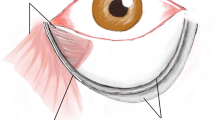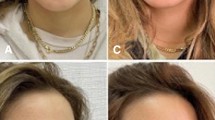Abstract
Background
Correction of tear trough (TT) deformity is a crucial aspect of facial rejuvenation. Because the anatomical origins of TT deformity lie in the TT ligaments, which firmly attach the dermis to the periosteum, the release of TT ligaments should be considered when performing an etiological correction. The aim of this paper is to propose an alternative method for TT deformity correction, comprising use of filler together with the release of TT ligaments. This technique was compared to the procedure of only percutaneous filler.
Methods
From January 2014 to December 2015, 10 patients were enrolled in the study for recurrence of TT deformity. All the patients underwent TT ligament release and filler injections; all had been previously treated with percutaneous hyaluronic acid injection without ligament release. Under local anesthesia, the TT ligaments were detached using a blunt cannula introduced directly in the supra periosteal plane through an intraoral access. Once the ligament was released, the TT depression was evenly recontoured with a very small amount of filler. The clinical data, digital images, evaluations of outcomes, including patient satisfaction rates were collected and compared.
Results
Adding the procedure of TT ligament release to filler injections showed satisfactory results, avoiding an unnatural puffy appearance. The comparison between the two different methods showed improved outcomes and increased patient satisfaction with minor patient discomfort among those who underwent TT ligament release.
Conclusion
Because TT ligaments are among the etiologic factors of TT deformity, they have a strong impact on procedures that are designed to improve TT deformity; therefore, TT ligament release should always be considered to obtain satisfactory, natural results.
Level of Evidence IV
This journal requires that authors assign a level of evidence to each article. For a full description of these Evidence-Based Medicine ratings, please refer to the Table of Contents or the online Instructions to Authors www.springer.com/00266.





Similar content being viewed by others
References
Lambros V (2007) Observations on periorbital and midface aging. Plast Reconstr Surg 120:1367–1376 (discussion 1377)
Glaser DA, Patel U (2010) Enhancing the eyes: use of minimally invasive techniques for periorbital rejuvenation. J Drugs Dermatol 9:118–283
Kikkawa DO, Lemke BN, Dorzbach RK (1996) Relations of the superficial musculoaponeurotic system to the orbit and characterization of the orbitomalar ligament. Ophtalm Plast Reconstr Surg 12:77–88
Muzaffar AR, Mendelson BC, Adams WP (2002) Surgical anatomy of the ligamentous attachments of the lower lid and lateral cathus. Plast Reconstr Surg 110:873–884
Withnall ES (1932) Anatomy of the human orbit. Oxford Medial Publishing, London, pp 119–120
Mendelson BC, Muzaffar AR, Adams WP (2002) Surgical anatomy of the midcheek and malar mounds. Plast Reconstr Surg 110(3):885–896
Salman A, Mikhail M (2013) Periocular hyperpigmentation: a review of etiology and current treatment options. J Drugs Dermatol 12:154–157
Duke-Elder S, Wybar KC (1961) The eyelids. In: Duke-Elder S (ed) System of Ophthalmology: the anatomy of the visual system, vol 2. C.V. Mosby Co, St. Louis
Flowers RF (1993) Tear trough implants for correction of tear trough deformity. Clin Plast Surg 20:403–415
Wong CH, Hsieh MKH, Mendelson B (2012) The tear trough ligament: anatomical basis for the tear trough deformity. Plast Reconstr Surg 129(6):1292–1402
Stuzin JM, Baker TJ, Gordon HL (1992) The relationship of the superficial and deep facial fascias: relevance to rhytidectomy and aging. Plast Reconstr Surg 89:441–449 (Discussion 450–451)
Acknowledgements
The authors declare that they have no conflicts of interest to disclose. None of the authors has a financial interest in any of the products, devices, or drugs mentioned in this manuscript.
Author information
Authors and Affiliations
Corresponding author
Ethics declarations
Ethical Approval
All the procedures performed in studies involving human participants were in accordance with the ethical standards of the institutional and national research committee and with the 1964 Helsinki declaration and its later amendments or comparable ethical standards.
Electronic supplementary material
Below is the link to the electronic supplementary material.
Rights and permissions
About this article
Cite this article
Innocenti, A., Melita, D., Ghezzi, S. et al. Refinements in Tear Trough Deformity Correction: Intraoral Release of Tear Trough Ligaments: Anatomical Consideration and Clinical Approach. Aesth Plast Surg 42, 1576–1581 (2018). https://doi.org/10.1007/s00266-018-1245-4
Received:
Accepted:
Published:
Issue Date:
DOI: https://doi.org/10.1007/s00266-018-1245-4




